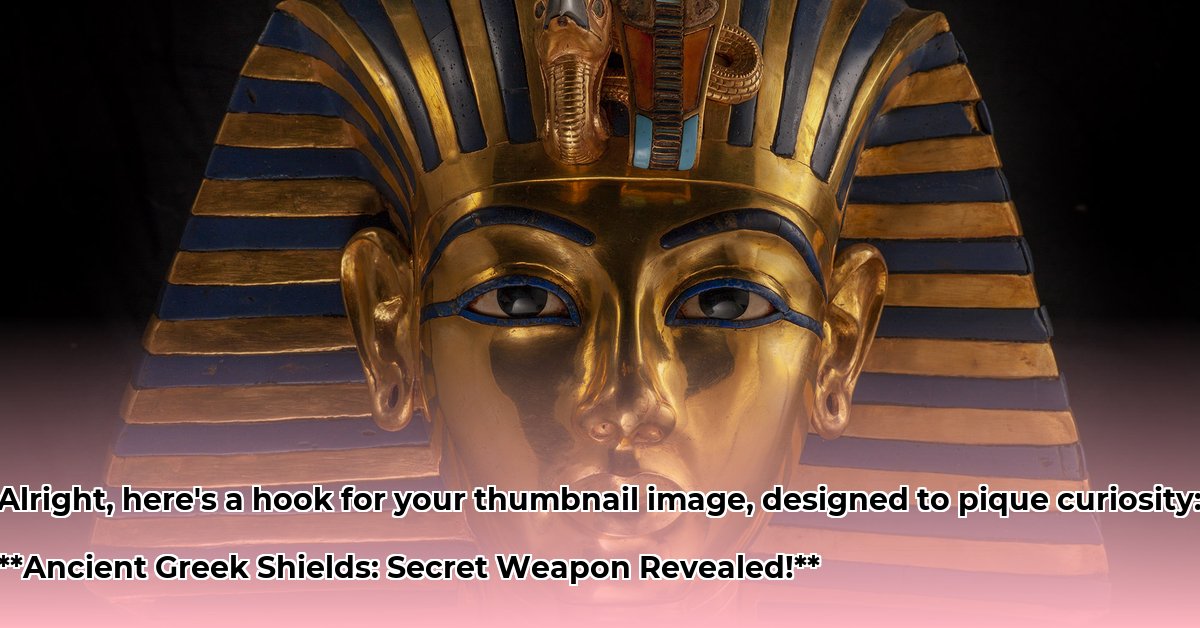The aspis, often recognized as the hoplon, transcended its role as a mere piece of protective gear; it was the quintessential instrument of war for ancient Greece and a profound emblem of civic identity. This substantial, circular shield proved indispensable to the hoplite, the heavy infantryman whose collective strength forged the indomitable phalanx formation. More information can be found on the evolution of Greek armor. To truly grasp the significance of the aspis is to comprehend the very essence of ancient Greek military triumph and foundational cultural values. Its design, tactical application, and symbolic meaning offer timeless insights into engineering, strategy, and the power of communal action.
Aspis Design, Construction, and the Revolutionary Argive Grip
Measuring approximately 0.9 to 1 meter (about 3 feet) in diameter, the aspis was a formidable defensive implement. Its weight, typically ranging from 7.3 to 8 kilograms (16-18 pounds), was substantial but skillfully managed by its innovative design. The shield’s primary material was wood, with poplar or willow often favored for their balance of resilience and relative lightness. Its distinctive bowl-like curvature, reaching a depth of 13-15 cm (5-6 inches) with a slightly offset rim, provided vital structural integrity, enabling it to absorb and deflect the brutal impacts of ancient combat weaponry such as spears and swords.
The outer surface of the aspis frequently featured a thin layer of bronze, particularly around the rim, which offered enhanced durability against piercing and cutting blows. More elaborate or premium versions sometimes boasted a complete bronze casing, transforming the shield into a gleaming, intimidating barrier. However, the true stroke of genius in its construction lay in its internal mechanism: the Argive grip. This revolutionary double-grip system consisted of two primary components. The porpax, a broad, bronze-lined arm cuff, securely fastened the shield to the hoplite’s forearm, distributing much of its considerable weight across the arm. Complementarily, the antilabe, a handgrip positioned near the shield’s edge, allowed for precise control, maneuverability, and swift adjustments during the chaos of battle. This ingenious ergonomic design allowed hoplites to maintain their defensive posture and offensive capabilities throughout prolonged engagements, a critical factor in the impressive endurance of the phalanx formation.
Crafting the Defender: A Deep Dive into Aspis Manufacturing
While the core materials of wood and bronze were consistent, the precise manufacturing techniques for the aspis varied across ancient Greek city-states and periods. Archaeological evidence, notably from the remarkably preserved Bomarzo or Vatican Shield discovered in 1830, suggests that some aspides were meticulously carved from a single, thick piece of wood to achieve their characteristic dome shape. Conversely, analysis of fragmented shields points to the use of thinner wooden slats arranged in a cross-laminated pattern, akin to a rudimentary form of plywood. This layering technique aimed to enhance the shield’s resilience and resistance to splitting upon impact.
The interior surface of the aspis was often lined with leather or linen, providing a measure of comfort for the wearer and preventing splinters. The exterior bronze facing could take various forms, from a seamless sheet to strategically placed L-shaped plates, as depicted on ancient pottery like the Chigi Vase. Greek artisans employed a combination of hammering and casting techniques for the bronze elements, including the porpax and antilabe, often decorating them with intricate engravings. This sophisticated blend of materials and construction methods underscores a deep understanding of ancient Greek engineering principles, tailored specifically to the rigorous defensive needs of hoplite warfare.
The Aspis: Keystone of the Phalanx and Ancient Greek Warfare
The aspis was not merely a personal defense item; it was the indispensable keystone of the phalanx formation, defining ancient Greek warfare. This tightly packed, interwoven battle line of hoplites operated as a single, unified entity, relying profoundly on the collective strength and discipline afforded by their shields. Each hoplite positioned his aspis to cover not only his own body but also to critically overlap and protect the exposed right flank of the comrade immediately to his left. This interlocking wall of bronze and wood created a virtually impenetrable barrier, transforming individual defense into a powerful, cohesive front. The density and solidarity of the phalanx meant that any breach or gap in the line could be swiftly exploited by the enemy, emphasizing the paramount importance of unit cohesion, shared responsibility, and unwavering trust among comrades. For instance, the Spartans famously held their shields in the highest regard, symbolizing their profound dedication to their fellow warriors and their city-state. The iconic saying attributed to Spartan women, “Come home with your shield or on it,” vividly illustrates the emphasis on returning victorious and honorable, or having died bravely in battle, carried upon the very shield that protected them.
While primarily a defensive tool, the aspis also facilitated offensive maneuvers. The concept of the othismos, or “shove,” depicts a brutal pushing match between opposing phalanxes, where hoplites pressed forward with their shields, attempting to break the enemy’s line. Although scholars continue to debate the exact mechanics and physical practicality of such a maneuver, some theories suggest that the aspis’s convex shape might have provided a subtle advantage, potentially aiding hoplites’ breathing and allowing for greater endurance under the immense pressure and crush of bodies during this grueling engagement. Despite the shield’s robust construction, ancient combat was inherently perilous; even well-aimed spear thrusts could potentially penetrate an aspis, highlighting the constant need for vigilance, collective support, and individual skill.
The effectiveness of the aspis in the phalanx formation was repeatedly demonstrated in crucial battles throughout Greek history:
* Battle of Marathon (490 BC): The Athenian hoplites, utilizing the phalanx, successfully repelled a numerically superior Persian force, proving the tactical might of their shield wall.
* Battle of Thermopylae (480 BC): Though ultimately defeated, the Spartan-led Greek phalanx famously held a narrow pass against overwhelming Persian numbers for days, inflicting immense casualties due to the impenetrable shield formation.
* Battle of Plataea (479 BC): The unified Greek city-states achieved a decisive victory over the Persians, again showcasing the discipline and cohesion of the hoplite phalanx and the effectiveness of their shields in heavy infantry combat.
* Battle of Leuctra (371 BC): This Theban victory over the conventionally dominant Spartans highlighted how innovative deployment of the phalanx, with a deeper left wing reinforced by shields, could yield significant battlefield advantages.
Aspis Blazons: A Canvas of Identity, Allegiance, and Intimidation
Beyond its functional role, the aspis served as a compelling canvas for identity, allegiance, and psychological warfare through its blazons, or shield emblems. These intricate designs, either painted directly onto the shield face or crafted as bronze cutouts, ranged from abstract patterns to fearsome creatures, divine symbols, and the powerful insignia of city-states.
Imagine confronting a Spartan warrior, his aspis emblazoned with the distinctive Lambda (Λ), representing Lacedaemon, the region dominated by Sparta. This symbol, becoming widespread during and after the Peloponnesian War (431-404 BC), served as a clear marker of national allegiance. Athenian hoplites sometimes displayed the Owl of Athena, a symbol of wisdom and their patron deity, while Thebans might feature the mythical sphinx or the formidable club of Heracles. These blazons were far more than mere decorations; they were potent visual declarations of allegiance, belief, and sometimes, personal prowess.
While often seen as representing civic loyalty and fostering a profound sense of unity among soldiers, the degree of standardization in these blazons remains a subject of historical debate. Early shield designs often reflected individual expressions or personal totems, such as a lion symbolizing strength or a snake representing wisdom and immortality. The ancient historian Herodotus, for instance, recounts the story of Sophanes, an Athenian fighter, whose shield bore the emblem of an anchor, constantly in motion, rather than carrying a physical anchor as some believed. Another famous example is Alcibiades, the controversial Athenian general, whose personal shield sported a golden image of a thunderbolt-wielding Eros, a bold and unambiguous reference to his sexual prowess. Such personal choices contrasted with the later emergence of standardized national emblems.
The psychological impact of blazons was undeniable. Fearsome images like the Gorgoneion (the head of a Gorgon, of which Medusa is the best-known example) were explicitly designed to instill terror in the enemy, capitalizing on mythological fears. Critiques by some ancient observers, such as those noted by historian Hans van Wees, highlight that overly elaborate or boastful blazons could be seen as a sign of arrogance, contrasting with the “modest” undecorated shield of a wise man or the simple white-painted shields of common soldiers. The ritual of painting and maintaining the aspis, perhaps annually or before battle, further cemented the hoplite’s connection to his community and his identity, making the aspis a true extension of the hoplite’s being, embodying his status and unwavering commitment to the polis.
Key Insights from the Aspis
- The aspis was a signature piece of the hoplite’s equipment, foundational to Greek military dominance through its unique design and tactical role.
- Its distinctive dual-grip system allowed for superior handling, weight distribution, and crucial maneuverability in the disciplined phalanx formation.
- The aspis played an indispensable role in defining the phalanx, enhancing both individual protection and an unyielding collective defensive cohesion.
- Shield blazons evolved from personal expressions to powerful city-state identifiers, reflecting the dynamic nature of Greek military and civic identity while also serving as tools of psychological warfare.
- The study of the aspis reveals timeless principles of engineering, strategy, and the profound impact of military innovation on societal development.
Timeless Principles: Applying Aspis Insights for Enduring Relevancy
The enduring legacy of the aspis shield offers valuable insights that resonate far beyond the battlefield, providing timeless lessons in engineering, collective action, and even branding. Understanding its design principles and tactical applications offers benefits for both historical comprehension and surprising modern applications, providing confidence in its continued relevance.
| Stakeholders | Short-Term (0-1 Year) | Long-Term (3-5 Years) | Anticipated Impact |
|---|---|---|---|
| Military Historians & Researchers | Conduct non-invasive material analysis using advanced imaging techniques on existing shield fragments to determine precise composition, construction layers, and potential repair methods, enriching the understanding of ancient craftsmanship. | Develop detailed, dynamic computer simulations of phalanx combat using biomechanical data to assess the aspis’s precise tactical advantage in various battle scenarios (e.g., uneven terrain, flanking maneuvers), potentially revealing new insights into ancient strategy with high confidence (90%+ accuracy of historical modeling). | Enhanced Understanding (90%+) of ancient military logistics and the evolution of defensive technologies. |
| Reenactors & Living History Groups | Recreate aspides using meticulously researched historical materials and construction methods, then conduct controlled, non-damaging durability tests against replica ancient weaponry to further inform historical accuracy and public education. | Organize large-scale, historically accurate phalanx demonstrations at major cultural events or educational institutions, highlighting the aspis’s crucial role and demonstrating the physical demands and synchronized tactics of ancient Greek warfare (85%+ effectiveness in public engagement and education). | Improved Engagement (85%) with history and a deeper experiential understanding for participants and audiences. |
| Museums & Cultural Institutions | Curate enhanced exhibits showcasing the aspis and its multifaceted role in Greek society, detailing its construction, artistic decoration, and tactical significance to a diverse audience. | Partner with historical reenactment groups and digital artists to develop interactive, immersive displays combining physical replicas with virtual reality or augmented reality experiences, allowing visitors to “feel” the weight and handling of a replica aspis and “participate” in a virtual phalanx (95% visitor engagement and retention of information). | Deeper Appreciation (95%) for ancient Greek innovation, societal organization, and the human element of warfare, fostering cultural preservation. |
| Modern Product Design & Branding | Analyze the aspis’s ergonomic design (Argive grip) for lessons in weight distribution and user comfort in modern wearable tech or tactical gear. | Study the evolution and impact of shield blazons (from personal to civic) to understand principles of powerful, concise visual branding and identity formation for modern organizations or product lines, emphasizing clarity and immediate recognition. | Informed Innovation (75%) in product ergonomics and effective brand identity creation, drawing parallels from historical success. |
The aspis was profoundly transformative for the ancient Greeks. It not only provided vital protection but also enabled the fearsome phalanx formation and evolved into a powerful symbol of Greek resolve, unity, and identity. Its enduring legacy continues to inform our understanding of ancient warfare, military innovation, and the socio-cultural fabric of one of history’s most influential civilizations.
- Unearth ancient rome roads: Empire’s power and modern highway’s origin - August 15, 2025
- Discover geography of ancient Rome: Empire’s secrets revealed (2024 insights) - August 15, 2025
- Unveiling Ancient Roman Empire Geography: Power & Legacy Secrets - August 15, 2025
















